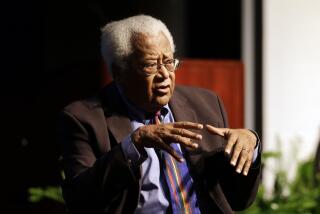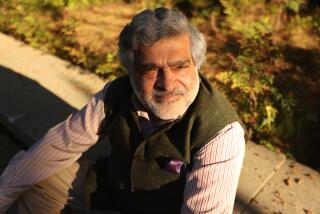Slain Leader Still Lives in Hearts of Followers
- Share via
For Rabbi Bernard P. King, the moment that changed his life came in a hallway of an Alabama airport in 1965, when he shook Dr. Martin Luther King Jr.’s hand and knew “he was definitely one of the great human beings to walk the earth.”
For the Rev. Samuel Craig Jr., that moment occurred at a 1956 meeting of ministers in Montgomery, Ala., when Dr. King volunteered to help blacks anywhere in the country fight for civil rights.
Bernard King, now the head rabbi of a Newport Beach temple, was one of 25,000 protesters on the 54-mile march from Selma to Montgomery in 1965. Craig, now an assistant pastor of a Baptist church in Santa Ana, met Dr. King in 1954, when King was minister of the Dexter Baptist Church in Montgomery.
The two Orange County religious leaders come from different worlds--one from Los Angeles and a rabbinical school, the other from the South and the Marine Corps. But they share similar memories of King and his contributions as Martin Luther King Jr. Day approaches Monday.
“I remember listening to the screams of the women and children, over the radio, who were being attacked by the police and the dogs,” King, then a 27-year-old rabbinical student at Hebrew Union College in Los Angeles, said of reports on the 1965 march from Selma to Montgomery. “And I said to myself, ‘We need white support to show that it’s not just blacks fighting for civil rights.’ ”
A chartered flight brought the rabbi and other civil rights supporters to the muddy fields of St. Jude’s Church in Montgomery for the last 2 days of the march.
“Being a part of the march was the first time I was putting my money where my mouth was,” said King, who heads the Shir Ha-Ma’Alot Harbor Reform Temple. At the time, he said, he thought to himself, “ ‘what if I got hurt?’ That’s when I started getting scared.”
By the time he joined the march, the protesters were predominantly white. However, King said he and many other white protesters “saw the world through black eyes for just a moment. The only time I felt secure was when I was around blacks.
“I remember being terrified after seeing black and white segregated bathrooms and realizing the difference in their lives.”
But the feeling of fear subsided as the young rabbinical student neared the steps of the Montgomery Capitol, he recalled.
“They had the women and children walk in the middle of the group and the men walked on the outside, because whites who gathered around as we walked down the streets were throwing punches and rocks and bottles at us,” he said. “Even the National Guard (officers), who were brought there to protect us, were hurling epithets at us.”
The last day of the march brought the religious student and the other protesters through a poor black Montgomery neighborhood, where they passed the Loveless Elementary School.
“There were little kids standing in front of the school carrying little flags and signs that read ‘Welcome Dr. King,’ ” he said.
And as they approached the school, an elderly black woman broke through the marchers and “started dancing and singing in front of the crowd and the police, ‘I’s free. I’s free.’ Her face just shone. I can remember her so clearly,” King said. “I guess it was like kind of a defiance.
“I guess she was so symbolic of black people at that time who had been held down because of the color of their skin. . . . It must have been the first time in her life when she could do something like that. . . . In that one moment, she was free.”
In that moment too, a young man’s fear vanished, he said. “I knew then that I . . . that we had accomplished something, that there was a true purpose.”
At the time of the Rev. Martin Luther King Jr.’s death in 1968, Rabbi King, then a rabbinical student in Cincinnati, made his usual weekend trip to Mattoon, Ill., to teach and hold religious services at the town temple. At the local hotel, the American flag waved, but not at half-staff.
“I asked the manager why he didn’t have the flag at half-mast and he asked, ‘Why should I put it at half-mast?’ When I told him that Dr. King died the day before, he still asked me why. And then I explained the kind of man Dr. King was. When I came back down from my room, the flag was at half-mast.”
For the Rev. Craig, who was raised in Montgomery, segregated bathrooms were part of growing up.
“We stayed in our place. That’s all that we knew,” said Craig, a pastor at the Second Baptist Church in Santa Ana. “But if you (whites) burned down my house, I was gonna burn down yours. But I was gonna do it without anyone finding out. . . .”
Dr. King “changed that. . . . He taught those people (blacks) how to forgive a person, even when they finished slapping you in the face.”
A chaplain in the Marine Corps, Craig left Montgomery in 1951 to fight in the Korean War. When the war ended, he remained in the Marines in North Carolina, returning occasionally to check on his wife and child “because of all the rioting and threatening that was going on.”
In 1956, Craig returned to witness the Montgomery bus boycott, sparked in 1955 when Rosa Parks, a black passenger, refused to give up her seat on a public bus for a white passenger. The boycott, which lasted nearly a year, was organized by the Rev. King.
“It wasn’t the first time a boycott had been attempted,” Craig said. “But Dr. King had a way to rouse the people, even those who had a . . . fear of speaking out for what they believed. . . .
“It just got to a point where everyone joined together in a mass--old, young . . . everybody. . . . I had to come back that time (1956) to make sure my wife was OK, because a mob of white people had surrounded Dr. (Ralph) Albernathy’s First Baptist Church during one of the mass meetings.”
It was at the end of that boycott, Craig said, that he first saw King as the true leader of blacks. At a meeting of ministers that followed, King was discussing strategy and asking where they were needed next.
“All he kept asking was, ‘Who needs us? Who needs us?’ ” Craig said. “If they needed him in Tennessee, he’d go to Tennessee. . . . He was something that I don’t ever think I’ll see again. You talk about prophets, well, King was like a Moses.”
Craig holds his personal memorial for King quietly in his Santa Ana home. “In my life span, he was the only man worthy of a holiday for all of the things he did.”
He began to weep softly. “You just don’t understand. You can’t understand.
“I’ll never be able to justify the love and respect I have for that man,” he said. “If I had half of a half of a half of his humility, I’d be happy.”
More to Read
Sign up for Essential California
The most important California stories and recommendations in your inbox every morning.
You may occasionally receive promotional content from the Los Angeles Times.









